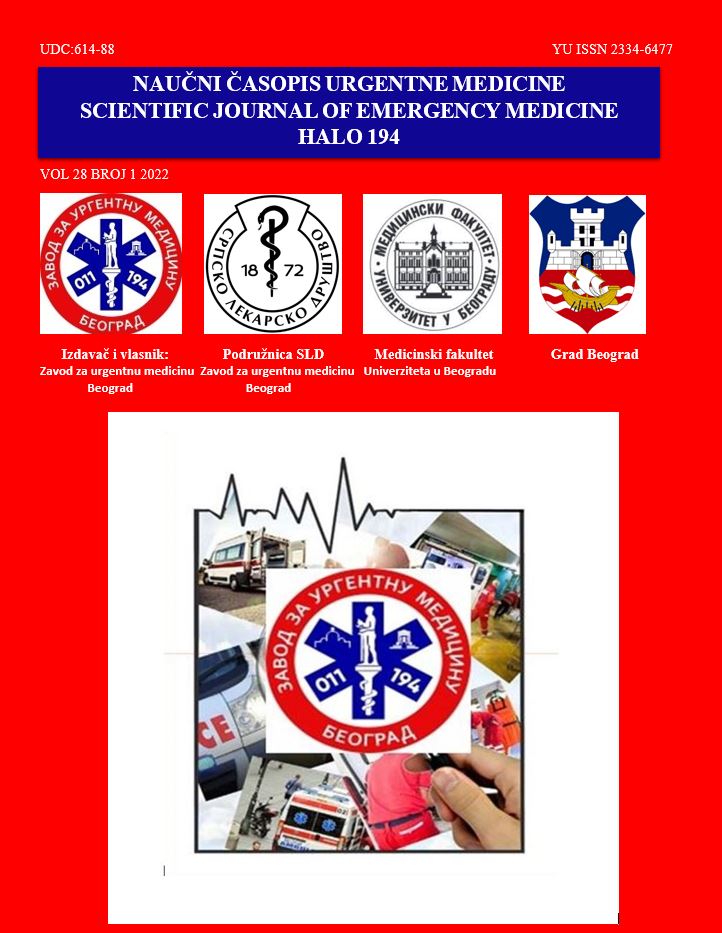An everyday clinical challenge in the COVID 19 pandemic era – how to treat patients with pulmonary embolism and hemoptysis
COVID 19 and pulmonary embolism
Abstract
Introduction. Pulmonary embolism (PE) is a relatively common complication in COVID 19. The cornerstone of PE medical treatment is anticoagulant therapy. However, anticoagulants may cause severe bleeding. Patients with PE and hemoptysis are often very difficult to treat.
Case report. We presented a case of a young patient who developed a COVID 19 induced pneumonia. During hospital treatment, he developed PE why the dose of anticoagulants was increased. Soon after the dose was increased, the patient developed massive hemoptysis. A team of physicians decided to continue with anticoagulants and to introduce a hemostatic into the therapy. The patient responded well to the therapy and he was dismissed from the hospital after two weeks of treatment.
Conclusion. Patients with PE and hemoptysis are often difficult to treat as the treatment of PE can worsen hemoptysis. This is why the decision on the treatment should be made by a team of physicians.
References
- Klok FA, Kruip MJHA, van der Meer NJM, Arbous MS, Gommers DAMPJ, Kant KM, et al. Incidence of thrombotic complications in critically ill ICU patients with COVID-19. Thromb Res. 2020; 191: 145-7. doi: 10.1016/j.thromres.2020.04.013.
- Goeijenbier M, van Wissen M, van de Weg C, Jong E, Gerdes VE, Meijers JC, et al. Review: Viral infections and mechanisms of thrombosis and bleeding. J Med Virol. 2012; 84(10): 1680-96. doi: 10.1002/jmv.23354.
- Hess DC, Eldahshan W, Rutkowski E. COVID-19-Related Stroke. Transl Stroke Res. 2020; 11(3): 322-5. doi: 10.1007/s12975-020-00818-9.
- Davoodi L, Jafarpour H, Taghavi M, Razavi A. COVID-19 Presented With Deep Vein Thrombosis: An Unusual Presenting. J Investig Med High Impact Case Rep. 2020; 8: 2324709620931239. doi: 10.1177/2324709620931239.
- Stefanini GG, Montorfano M, Trabattoni D, Andreini D, Ferrante G, Ancona M, et al. ST-Elevation Myocardial Infarction in Patients With COVID-19: Clinical and Angiographic Outcomes. Circulation. 2020; 141(25): 2113-26. doi: 10.1161/CIRCULATIONAHA.120.047525.
- Léonard-Lorant I, Delabranche X, Séverac F, Helms J, Pauzet C, Collange O, et al. Acute Pulmonary Embolism in Patients with COVID-19 at CT Angiography and Relationship to d-Dimer Levels. Radiology. 2020; 296(3): E189-91. doi: 10.1148/radiol.2020201561.
- Danzi GB, Loffi M, Galeazzi G, Gherbesi E. Acute pulmonary embolism and COVID-19 pneumonia: a random association? Eur Heart J. 2020; 41(19): 1858. doi: 10.1093/eurheartj/ehaa254.
- Konstantinides SV, Meyer G, Becattini C, Bueno H, Geersing GJ, Harjola VP, et al.; ESC Scientific Document Group. 2019 ESC Guidelines for the diagnosis and management of acute pulmonary embolism developed in collaboration with the European Respiratory Society (ERS). Eur Heart J. 2020; 41(4): 543-603. doi: 10.1093/eurheartj/ehz405.
- Lauzier F, Arnold DM, Rabbat C, Heels-Ansdell D, Zarychanski R, Dodek P, et al. Risk factors and impact of major bleeding in critically ill patients receiving heparin thromboprophylaxis. Intensive Care Med. 2013; 39(12): 2135-43. doi: 10.1007/s00134-013-3044-3.
- Lippi G, Favaloro EJ. d-Dimer is associated with severity of coronavirus disease 2019: a pooled analysis. Thromb Haemost. 2020; 120(5): 876–8. doi: 10.1055/s-0040-1709650.
- Sakr Y, Giovini M, Leone M, Pizzilli G, Kortgen A, Bauer M, et al. Pulmonary embolism in patients with coronavirus disease-2019 (COVID-19) pneumonia: a narrative review. Ann Intensive Care. 2020; 10: 124. doi: 10.1186/s13613-020-00741-0.
- Bikdeli B, Madhavan MV, Jimenez D, Chuich T, Dreyfus I, Driggin E, et al.; Global COVID-19 Thrombosis Collaborative Group, Endorsed by the ISTH, NATF, ESVM, and the IUA, Supported by the ESC Working Group on Pulmonary Circulation and Right Ventricular Function. COVID-19 and Thrombotic or Thromboembolic Disease: Implications for Prevention, Antithrombotic Therapy, and Follow-Up: JACC State-of-the-Art Review. J Am Coll Cardiol. 2020; 75(23): 2950-73. doi: 10.1016/j.jacc.2020.04.031.
- Suh YJ, Hong H, Ohana M, Bompard F, Revel MP, Valle C, et al. Pulmonary Embolism and Deep Vein Thrombosis in COVID-19: A Systematic Review and Meta-Analysis. Radiology. 2021; 298(2): E70-80. doi: 10.1148/radiol.2020203557.
- Scudiero F, Silverio A, Di Maio M, Russo V, Citro R, Personeni D, et al.; Cov-IT Network. Pulmonary embolism in COVID-19 patients: prevalence, predictors and clinical outcome. Thromb Res. 2021; 198: 34-9. doi: 10.1016/j.thromres.2020.11.017.
- Bidwell JL, Pachner RW. Hemoptysis: diagnosis and management. Am Fam Physician. 2005; 72(7): 1253-60.
- Sakr L, Dutau H. Massive hemoptysis: an update on the role of bronchoscopy in diagnosis and management. Respiration. 2010; 80(1): 38-58. doi: 10.1159/000274492.
- Earwood JS, Thompson TD. Hemoptysis: evaluation and management. Am Fam Physician. 2015; 91(4): 243-9.
- Stein PD, Terrin ML, Hales CA, Palevsky HI, Saltzman HA, Thompson BT, et al. Clinical, laboratory, roentgenographic, and electrocardiographic findings in patients with acute pulmonary embolism and no pre-existing cardiac or pulmonary disease. Chest. 1991; 100(3): 598-603. doi: 10.1378/chest.100.3.598.
- Huang C, Wang Y, Li X, Ren L, Zhao J, Hu Y, et al. Clinical features of patients infected with 2019 novel coronavirus in Wuhan, China. Lancet. 2020; 395(10223): 497-506. doi: 10.1016/S0140-6736(20)30183-5.
- Autori zadržavaju autorska prava i pružaju časopisu pravo prvog objavljivanja rada i licenciraju ga "Creative Commons Attribution licencom" koja omogućava drugima da dele rad, uz uslov navođenja autorstva i izvornog objavljivanja u ovom časopisu.
- Autori mogu izraditi zasebne, ugovorne aranžmane za neekskluzivnu distribuciju članka objavljenog u časopisu (npr. postavljanje u institucionalni repozitorijum ili objavljivanje u knjizi), uz navođenje da je članak izvorno objavljen u ovom časopisu.
- Autorima je dozvoljeno i podstiču se da postave objavljeni članak onlajn (npr. u institucionalni repozitorijum ili na svoju internet stranicu) pre ili tokom postupka prijave rukopisa, s obzirom da takav postupak može voditi produktivnoj razmeni ideja i ranijoj i većoj citiranosti objavljenog članka (Vidi Efekti otvorenog pristupa).

